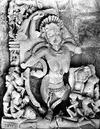- Kali
-
/kah"lee/, n. Hinduism.
* * *
Destructive and devouring Hindu goddess.She is a terrifying aspect of Devi, who in other forms appears as peaceful and benevolent. Kali is commonly associated with death, violence, sexuality, and, paradoxically, with motherly love. Noted for killing the demon Raktavija, she is usually depicted as a hideous, black-faced hag smeared with blood. In her four hands she holds, variously, a sword, a shield, the severed head of a giant, or a noose for strangling. Nearly naked, she wears a garland of skulls and a girdle of severed hands. She is often shown standing or dancing on her husband, Shiva. Until the 19th century the thugs of India worshiped Kali and offered their victims to her. In the late 20th century she became a symbol of feminine empowerment in some circles. Kali, sandstone relief from Bheraghat, near Jabalpur, Madhya Pradesh state, India, 10th century ...Pramod Chandra
Kali, sandstone relief from Bheraghat, near Jabalpur, Madhya Pradesh state, India, 10th century ...Pramod Chandra* * *
▪ Hindu goddessin Hinduism, goddess of time, doomsday, and death, or the black goddess (the feminine form of Sanskrit kala, “time-doomsday-death,” or “black”). Kali's iconography, cult, and mythology commonly associate her with death, sexuality, violence, and, paradoxically in some later traditions, with motherly love. Although depicted in many forms throughout South Asia (and now much of the world), Kali is most often characterized as black or blue, partially or completely naked, with a long lolling tongue, multiple arms, a skirt or girdle of human arms, a necklace of decapitated heads, and a decapitated head in one of her hands. She is often portrayed standing or dancing on her husband, the god Shiva, who lies prostrate beneath her.A precursor of Kali is the demoness Long Tongue, who licks up oblations in the ancient Sanskrit texts known as the Brahmanas (Brāhmaṇa). Kali's origins can also be traced to the deities of the village, tribal, and mountain cultures of South Asia who were gradually appropriated and transformed, if never quite tamed, by the Sanskritic traditions. She makes her first major appearance in Sanskrit culture in the Devi-mahatmya (“The Glorifications of the Goddess,” c. 6th century CE), where she springs from the anger of the goddess Durga to slay the demon Raktabija (“Blood-Seed”). During the struggle a new demon emerges from each drop of Raktabija's blood as it hits the ground; to prevent this, Kali laps up the blood before it can reach the ground. She is also said to have been born when the goddess Parvati (Pārvatī) shed her dark skin; the sheath became Kali—who is also called Kaushika, “The Sheath”—leaving Parvati in the form of Gauri (“The Fair One”).Worshipped throughout India but particularly in Kashmir, Kerala, South India, Bengal, and Assam, Kali is both geographically and culturally marginal. Since the late 20th century, feminist scholars and writers in the United States have seen Kali as a symbol of feminine empowerment, while members of New Age (New Age movement) movements have found theologically and sexually liberating inspiration in her more violent sexual manifestations.Wendy DonigerAdditional ReadingDavid Kinsley, The Sword and the Flute: Kālī and Krṣṇạ: Dark Visions of the Terrible and the Sublime in Hindu Mythology, 2nd ed. (2000), and Hindu Goddesses: Visions of the Divine Feminine in the Hindu Religious Tradition (1986, reissued 1997), are good introductions to traditions associated with Kali.Wendy Doniger* * *
Universalium. 2010.
